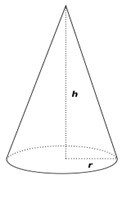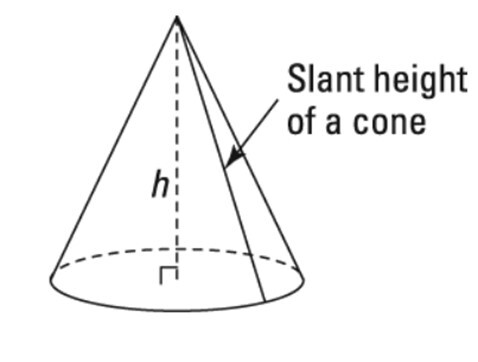
 Data Structure
Data Structure Networking
Networking RDBMS
RDBMS Operating System
Operating System Java
Java MS Excel
MS Excel iOS
iOS HTML
HTML CSS
CSS Android
Android Python
Python C Programming
C Programming C++
C++ C#
C# MongoDB
MongoDB MySQL
MySQL Javascript
Javascript PHP
PHP
- Selected Reading
- UPSC IAS Exams Notes
- Developer's Best Practices
- Questions and Answers
- Effective Resume Writing
- HR Interview Questions
- Computer Glossary
- Who is Who
Cone
Introduction
A cone has a curved surface at the bottom; therefore, it contains two surface areas that are total surface area is the total surface area covered by the cone, whereas the curved surface the area consists of the surface area covered by the curved surface, which is the surface area other than the bottom circular flat surface. A cone has a vertex or an apex and a slant height.
In this tutorial, we will discuss cones, slant height, curved surface area, total surface area, and a few solved examples.
Cones
Cones are three-dimensional figures with a circular surface at the bottom as a flat base and line segments from the circumference of the circle connecting towards a point called vertex or apex. It shapes like a pyramid but with a circular cross-section rather than a triangular cross-section.
A cone is a three-dimensional solid geometric object with an apex that is pointed at the top and a circular base. A cone has a vertex and one face. For a cone, there are no edges.

Slant Height
The slant height is defined as the distance between the vertex or apex to the circular base of the cone. The formula for slant height is derived from the Pythagoras theorem considering a right-angled triangle formed by the radius, height, and slant height of the cone.
The below figure has a cone in which all the measurements of a cone are represented.

$\mathrm{The\:slant\:height(l)\:of\:a\:cone\:is\:equal\:to\:l\:=\:\sqrt{h^{2}\:+\:r^{2}}}$
CSA of Cones
A Curved surface area is an area covered by the curved surface (the surface excluding the circular base) in a three-dimensional plane. In short, it is called CSA.
The curved surface area is the area without the flat surface which is the circular base of the cone.
The formula for curved surface area is equal to the product of pi times the radius of the cone and the slant height of the cone. It is measured in square units.
$\mathrm{The\:CSA\:of\:the\:cone\:=\:\pi\:\times\:r\times\:l}
And we know that $\mathrm{The\:slant\:height(l)\:of\:a\:cone\:is\:equal\:to\:l\:=\:\sqrt{h^{2}\:+\:r^{2}}}$
$$\mathrm{The\:CSA\:of\:the\:cone\:=\:\pi\:\times\:r\times\:\sqrt{h^{2}\:+\:r^{2}}}$$
TSA of Cones
The total surface area is an area covered by the entire cone both curved and flat surfaces in a three-dimensional plane. In short, it is called TSA.
It is equal to the sum of the curved surface area of the cone and the area of the circular base of the cone. The area of the circular base is equal to pi times the square of the radius of the cone.
We know the CSA of the cone now adding pi times the square of the radius of the cone to the CSA to get the TSA of the cone. It is measured in square units.
$\mathrm{The\:TSA\:of\:the\:cone\:=\:\pi\:\times\:r\times\:l\:+\:\pi\:\times\:r^{2}}$
$$\mathrm{The\:TSA\:of\:the\:cone\:=\:\pi\:\times\:r\times\:(l\:+\:r)}$$
And we know that $\mathrm{The\:slant\:height(l)\:of\:a\:cone\:is\:equal\:to\:l\:=\:\sqrt{h^{2}\:+\:r^{2}}}$
Hence $\mathrm{The\:TSA\:of\:the\:cone\:=\:\pi\:\times\:r\times\:(\sqrt{h^{2}\:+\:r^{2}}\:+\:r)}$
Volume of Cones
The amount of room or capacity a cone takes up is known as its volume. A cone's base is round, hence it is formed of a radius and a diameter. Then you can go from the center of the base to the topmost section of the cone, which is measured as the height (of course, in the case of ice cream, this area is at the bottom).
The area of the conical base multiplied by the height of the cone is multiplied by one-third to get the volume of a cone.
$\mathrm{The\:volume\:of\:a\:cone\:=\:\frac{1}{3}\pi\:r^{2}h}$
Solved Examples
1) Find the volume of a cone whose radius is 2m and height is 3?
Answer It is given that the radius is 2m and height is 3 and we know that the volume of a cube is given as
$$\mathrm{The\:volume\:of\:a\:cone\:=\:\frac{1}{3}\pi\:r^{2}h}$$
$$\mathrm{The\:volume\:of\:a\:cone\:=\:\frac{1}{3}\pi\:2^{2}h}$$
$$\mathrm{The\:volume\:of\:a\:cone\:=4\pi}$$
2) Find the CSA of a cone whose radius is 2 cm and slant height is 4cm?
Answer It is given that the radius is 2 cm and slant height is 4 and we know that the
$$\mathrm{The\:CSA\:of\:the\:cone\:=\:\pi\:\times\:r\times\:l}$$
$$\mathrm{=\:\pi\:\times\:2\times\:3}$$
$$\mathrm{The\:CSA\:of\:the\:cone\:=6\pi}$$
3) How is a cone defined in terms of faces, edges, and vertices?
Answer 2 faces, 1 edge, and 1 vertex
One of the faces is the circular base, the other is the continuous curved part.
The one and only edge is the edge of the circular base, where the two faces meet.
The vertex is the point at the top (the sharp corner).
4) Find the TSA of a cone whose radius is 2 cm and slant height is 3cm?
Answer It is given that the radius is 2 cm and the slant height is 3cm
Now apply the formula for the TSA of a cone in terms of radius and slant height that is
$$\mathrm{The\:TSA\:of\:the\:cone\:=\:\pi\:\times\:r\times\:l\:+\:\pi\:\times\:r^{2}}$$
$$\mathrm{=\:\pi\:\times\:2\times\:3\:+\:\pi\:\times\:2^{2}}$$
$$\mathrm{=\:10\pi}$$
Hence, $\mathrm{The\:TSA\:of\:the\:cone\:=\:10\pi}$
5) Find the slant height of a cone whose height is 5cm and radius is 12 cm?
Answer Given that the height is 5cm and radius is 12 cm and we know that
$\mathrm{The\:slant\:height(l)\:of\:a\:cone\:is\:equal\:to\:l\:=\:\sqrt{h^{2}\:+\:r^{2}}}$$$\mathrm{l\:=\:\sqrt{12^{2}\:+\:5^{2}}}$$
$$\mathrm{l\:=\:13}$$
Hence$\mathrm{The\:slant\:height(l)\:of\:a\:cone\:is\:equal\:to\:l\:=\:13}$
Conclusion
A cone is a 3D figure containing a circular base. It is like a pyramid; rather than a triangular base, it contains a circular base. The surface area of a cone is the surface covered by the cone. It has two surface areas: curved surface area and total surface area.
FAQs
1. What do you mean by cone?
Cones are three-dimensional figures with a circular surface at the bottom as a flat base and line segments from the circumference of the circle connecting towards a point called vertex or apex.
2. What is the difference between a pyramid and a cone?
Both are 3D figures with different bases, a pyramid has a triangular-shaped base whereas a cone has a circular-shaped base
3. What do you mean by the slant height of a cone?
The slant height is defined as the distance between the vertex or apex to the border of the circular base of the cone.
4. What are the different types of cones?
There are two types of cone
Right circular cone
Oblique cone.
5. What do you mean by oblique cone?
The cone has a circular-shaped base, and the apex and the center of the base don't lie on the same axis. The vertex doesn't lie above the center of the base.

